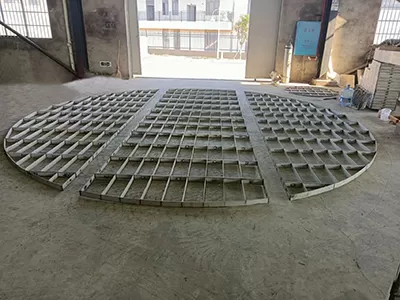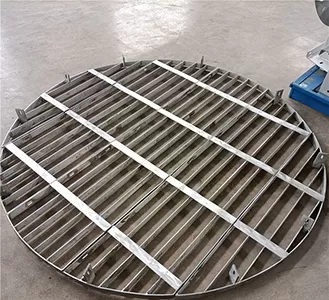Die Einbauten eines Turms sind ein wichtiger Bestandteil der Turmausrüstung. Ihre Funktion besteht darin, einen besseren Kontakt zwischen den Gas- und Flüssigkeitsphasen innerhalb des Turms zu ermöglichen und so die gewünschten Massen- und Wärmeübertragungseffekte zu erzielen. Im Folgenden werden die wichtigsten Arten von Turmeinbauten und Installationsvorkehrungen ausführlich erläutert:

1. Haupttypen von internals
1.1 Turmplatten (plattenförmige Turmeinbauten)

Bubble Turmplatte: Mit einem Rührrohr und einer Blasenkappe ist die Kontaktfläche zwischen Gas und Flüssigkeit groß, und die Betriebsflexibilität ist hoch, aber der Widerstand ist hoch und die Struktur ist komplex.
Siebplatte: Einfach im Aufbau und kostengünstig. Das Gas strömt durch die Sieblöcher und kommt mit der Flüssigkeit in Kontakt. Die Gasgeschwindigkeit muss kontrolliert werden, um Flüssigkeitsaustritt zu verhindern.
Floating Ventilturmplatte: Die schwimmenden Ventile können ihre Öffnung entsprechend der Gasgeschwindigkeit einstellen, und der Wirkungsgrad ist hoch, mit hoher Betriebsflexibilität. Es ist eine weit verbreitete Art von Turmplatte.
Tong-shaped Turmplatte: Das Gas wird aus den Zungenlöchern ausgestoßen, wodurch die Flüssigkeit zum Fließen gebracht wird. Der Druckabfall ist gering, und die Verarbeitungskapazität ist groß, aber der Wirkungsgrad ist gering.

01 Packungen (Packungen)
Schüttgut: Wie Raschig-Ringe, Bauer-Ringe, abgestufte Ringe und rechteckige Sattelringe, die zufällig im Turm gestapelt sind und eine relativ gleichmäßige Gas-Flüssigkeits-Verteilung aufweisen.
Regulated Packungen: Wie z. B. Drahtgeflecht-Wellpappungen und Wellpappenpackungen, die regelmäßig angeordnet sind, eine hohe Stoffübertragungseffizienz und einen geringen Widerstand aufweisen und sich für eine präzise Trennung eignen.
1,3 Verteiler Distributors
Liquid : Sorgt für eine gleichmäßige Verteilung der Flüssigkeit auf der Packungsfläche. Gängige Typen sind Schlitz-, Rohr- und Sprühverteiler.
Gasverteiler: Ermöglicht das gleichmäßige Eindringen des Gases in den Turm. Meistens Multi-Loch-Platten oder konische Strukturen.
1,4 Unterstützt structures

8packing Stützvorrichtung: Unterstützt das Gewicht der Packungen, wie Gitterplatten und Lochplattenstützen, um den Gasflussbereich zu gewährleisten.
Turmplattenstützvorrichtung: Unterstützt das Gewicht der Turmplatte und der Flüssigkeit, einschließlich Stützen, Balken und Flüssigkeitsabflussrohrträger.
1,5 Umverteilung device
Used in gepackten Türmen, um zu verhindern, dass Flüssigkeit in Richtung der Turmwand fließt. Gängige Typen umfassen Umverteilungsvorrichtungen vom Kegelstumpf und Schlitztyp.

1.6 eliminator
Installed an der Oberseite des Turms, um Flüssigkeitströpfchen von der Gasphase zu trennen. Gängige Typen umfassen Drahtgeflecht-Nebelabscheider und Prallnebelabscheider, wodurch Produktverluste und Umweltverschmutzung reduziert werden.
1,7 Flüssigkeitsabflussrohr (Plattenturm)
Führt die Flüssigkeit von der oberen Turmplatte zur unteren Platte, sorgt für einen reibungs

